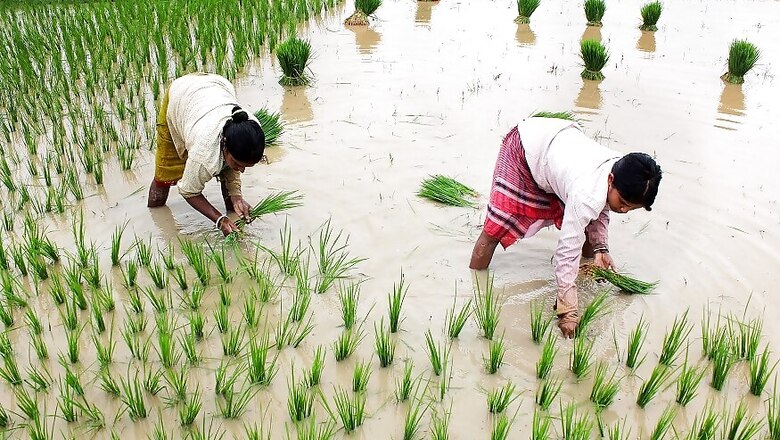
views
New Delhi: There is more to the five-and-half year high of 7.35 per cent retail inflation in December 2019, mainly due to increased vegetable prices, than what meets the eye.
That inflation in the vegetable segment spiked by 60.5 per cent as compared to December 2018 is the combined effect of climate change, inefficient trade systems due to no cash in rural economy and the rise in global food prices, experts told News18.
Abhijit Sen, an Economics professor at Jawaharlal Nehru University (JNU) and a former member of the erstwhile Planning Commission of India, explained that a major part of this ‘climate change-trade’ problem is related to demonetisation.
“We have a situation where trade continues to be in doldrums partly because of a forced cash-less rural economy, and export and import policies that have led to knee jerk reactions,” he said.
These policies, the professor said, have led to a certain peculiarity of very low and very high prices in commodities like vegetables which cannot be preserved or which have low shelf life. For instance, onion prices in India, which shot up to Rs 200 as recently as two months ago, witnessed a sharp fall to Rs 40 on Monday.
‘Knee Jerk Reactions’
Minister of Consumer Affairs, Food and Public Distribution, Ram Vilas Paswan on Tuesday said that of the total 18,000 tonnes of imported onions, only 2,000 has been sold, an indicator that further strengthens the case for an economy struggling to meet basic necessities. This imported onion, the minister noted, will now be sold at Rs 22 per kilogram.
Consumer food price inflation touched 14.42 per cent in December 2019 from a mere 2.99 per cent in August the same year, data from the National Statistical Office (NSO) has shown. This sharp rise, a six-year high since November 2013 when it was 18.89 per cent, was expected given increasing onion, tomato and dairy prices.
The damage to the kharif harvest due to sudden and prolonged rainfall contributed to the rise in food inflation over the last three months. Though one cannot wholly blame the government for “unusual weather, almost certainly related to climate change,” the lack of policies in such circumstances make things worse by effecting output, Sen said.
“The government is feeling the effect of a non-cash economy under stress due to climate change and inefficient trade systems, whereas the rural economy is largely a cash economy,” he told News18.
Global or Local?
As per the data released by National Statistical Office (NSO) on Monday, during the same period a rise in inflation for ‘pulses and products’ (15.44 per cent) and ‘meat and fish’ (10 per cent) was noted. This, experts have pointed out, is in line with the rise in global upswing in food prices. The UN Food and Agricultural Organization’s Food Price Index was estimated at 181.7 points in December 2019. The highest it has been in recent history was in December 2014 when it logged 185.8 points.
Avinash Kishore, a senior research fellow at the International Food Policy Research Institute (IFPRI) employed a two-way reasoning for the rise in retail inflation in the country. He said the global upswing in dairy prices may have caused inflation in India, but rise of vegetable prices is mainly internal and due to onion and tomato.
“Milk is linked to global price rise because of demands of powder and fat. Earlier the slump noted in India on diary price was connected to this. But, vegetable price rise is more local because though onion forms a small fraction of total vegetable budget, it witnessed an extraordinary inflation of nearly 300 per cent,” he said.
According to Kishore, given that onion price shot up mainly due to unseasonal rainfall, vegetable price inflation may not persist for a long time, but the fact that non-food inflation is low is a reason to worry. “Low core inflation or non-food inflation shows that the economy is facing a slowdown.”
The Case for Rising Pulses Inflation
With prices of pulses already on the rise, Kishore speculates that it will further continue to increase and effect food inflation. “In Indian agriculture, there are temporary price rises and prolonged price crashes. Our farmers are responsive with great elasticity today to rising prices, which eventually brings it down due to oversupply and there is eventually a crash.”
Here, making things worse is the “asymmetric response” that policy has within this responsive farmer environment. When price rises, the government bans exports, starts importing but when price crashes, then every bureaucrat fears reversing the policy.
“This is what happened with pulses. Everyone knew that area sown under pulses has increased, bumper production is anticipated but we didn’t reduce imports and remove the export bans in time,” said the food and policy expert.
Kishore noted that the problem lies in the fact that a bulk of this price increase never reaches the farmer. “Bulk of this benefit goes to anyone who has a speculation capacity, storage capacity and a risk taking capacity. But when the price crashes, the farmer is the first to suffer.”



















Comments
0 comment